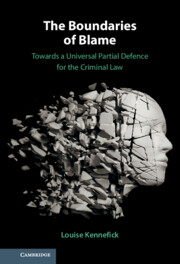
-
Select format
-
- Publisher:
- Cambridge University Press
- Publication date:
- July 2025
- August 2025
- ISBN:
- 9781009386142
- 9781009386104
- Dimensions:
- (229 x 152 mm)
- Weight & Pages:
- 0.64kg, 342 Pages
- Dimensions:
- Weight & Pages:
- Subjects:
- Law, Legal Philosophy, Criminal Law, Philosophy
You may already have access via personal or institutional login- Subjects:
- Law, Legal Philosophy, Criminal Law, Philosophy
Book description
How can our criminal law retain legitimacy in an era of growing awareness about the complexities of human vulnerability and the far-reaching harm of punitive attitudes? The Boundaries of Blame makes a fresh contribution to the evolving scholarship on the relationship between criminal responsibility and social justice. It challenges the constricted view of personhood underpinning doctrines of responsibility, encouraging new conversations about long-standing questions on the role of circumstances like deprivation and trauma in excusing wrongdoing. Testing entrenched boundaries can provoke resistance, but the book argues that pushing past these limits is essential to fostering a more just framework of state blame in our present time and place. To achieve this objective, Louise Kennefick proposes a bold yet pragmatic response in the form of a Universal Partial Defence, grounded in the Real Person Approach – a blueprint that offers a practical and humane pathway towards a fairer measure of criminal accountability.
Contents
Metrics
Altmetric attention score
Full text views
Full text views help Loading metrics...
Loading metrics...
* Views captured on Cambridge Core between #date#. This data will be updated every 24 hours.
Usage data cannot currently be displayed.
Accessibility standard: Missing or limited accessibility features
Why this information is here
This section outlines the accessibility features of this content - including support for screen readers, full keyboard navigation and high-contrast display options. This may not be relevant for you.
Accessibility Information
The PDF of this book is known to have missing or limited accessibility features. We may be reviewing its accessibility for future improvement, but final compliance is not yet assured and may be subject to legal exceptions. If you have any questions, please contact accessibility@cambridge.org.
Content Navigation
Table of contents navigation
Allows you to navigate directly to chapters, sections, or non‐text items through a linked table of contents, reducing the need for extensive scrolling.
Index navigation
Provides an interactive index, letting you go straight to where a term or subject appears in the text without manual searching.
Reading Order and Textual Equivalents
Single logical reading order
You will encounter all content (including footnotes, captions, etc.) in a clear, sequential flow, making it easier to follow with assistive tools like screen readers.
Visual Accessibility
Use of colour is not sole means of conveying information
You will still understand key ideas or prompts without relying solely on colour, which is especially helpful if you have colour vision deficiencies.
Use of high contrast between text and background colour
You benefit from high‐contrast text, which improves legibility if you have low vision or if you are reading in less‐than‐ideal lighting conditions.

